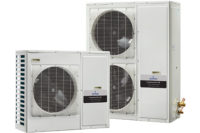
An outdoor condensing unit using scroll compressors was subject to a field trial study to measure its return on investment.
Two refrigeration contractors who do installation and service work in the restaurant sector were facing different challenges.
In one situation, a restaurant in New York City needed to add refrigeration capacity for walk-in freezers and coolers, but in a constrained space.
In another instance, a chain of restaurants was dealing with aging refrigeration equipment and the need to improve operating systems.
In both circumstances, the contractors turned to Emerson Climate Technologies for help, and in both cases, upgrades in the condensing units proved a key part in the solutions.
Here, based on material supplied by Emerson, is how the situations were dealt with.
THE MANHATTAN PROJECT
Gibsen HVAC, a refrigeration contractor in New York, does the service work for the Manhattan Diner at 94th and Broadway. It is a 24-hour restaurant on Manhattan’s Upper West Side.According to Gibsen, it was not possible to install conventional condensing units on the roof of the six-story building. Outside the diner, a 7-foot-wide alley was all that separated the restaurant from a hotel, so there were noise and space limits.
According to a statement from Emerson, “Indoor water-cooled condensing units with a cooling tower on the roof were initially being considered, but would add nearly $50,000 to the capital cost of the project. Placing the units inside was also a poor alternative since the equipment would take up valuable interior space.
“The restaurant’s owner was struggling to find a cost-effective and reliable refrigeration option which would fit his particular location and fall within his budget.”
Nick Benetos, owner of Gibsen, turned to the supply house ABCO Refrigeration and the equipment manufacturer to settle on the Copeland Scroll Outdoor Condensing Unit (XJ Series). The equipment was promoted as being high efficient with built-in protective diagnostics and installation flexibility.

New energy efficient equipment for walk-ins may have a two-year or less payback.
Noise concerns were addressed because of the mounting position and because, according to Emerson, the units have “scroll compressor’s low sound, along with a unique fan blade design and variable-speed fan motor control.”
Benetos was quoted as saying, “I can hardly hear them run. These are the quietest refrigeration units I have ever worked with.”
Among statistics supplied by Emerson regarding the project:
• There were lower investment costs by nearly $50,000 by not selecting a water-cooled design.
• Condensing units were expected to save about $2,400 in energy costs per year (at 16 cents/kWh) when compared to standard semi-hermetic condensing units.
• Operating sound output of 11-16 dBa was quieter than traditional outdoor units.
• Built-in Core Sense™ diagnostics provided Gibsen technicians with information for troubleshooting while avoiding unneeded service calls and protecting the system from premature failure.
“I knew I saved on the upfront installation cost,” said diner owner Frank Tsantsouris. “And the additional electricity cost savings will definitely help my bottom line over the long term.”

Condensing units are mounted high on a side wall in an alley to allow for ground passage below.
THE CHAIN OF COMMAND
The issue facing Medford, Mass.-based contractor Medford Wellington related to aging systems at some of the Bertucci’s Italian Restaurants, which overall has 80 locations.According to Medford Wellington, key areas of concern were:
• Walk-in refrigeration systems were employing “traditional, less efficient technologies,” while electricity rates had climbed to their highest levels, averaging 16 cents or more per kWh.
• Capital budgets for equipment upgrades were constrained, while utility companies were offering rebate incentives for proven energy-efficient technologies.
• Some walk-ins required an increasing number of service calls, raising annual service maintenance expenses above average at certain locations.
• While existing systems were generally reliable, when a failure did occur, repairs would take longer to perform than normal due to system design, adding to service costs.
According to Emerson, here was another aspect compounding the situations: “New energy-efficient refrigeration equipment is available for walk-in systems, but even with a two-year payback or less for the price premium, many operators remain reluctant to make the added upgrade investments.”
This meant the contractor had to demonstrate a return on investment (ROI). Part of the ROI for this situation was a field trial study of the XJ Series condensing unit. The unit’s performance and energy savings were measured for nearly a year in comparison to other standard equipment.
In addition to the condensing unit upgrade, the contractor replaced the hot gas defrost with what was called “a more suitable defrost scheme” and installed evaporator fan units with more efficient electronically commutated motors (ECMs).
Among aspects noted by the contractor and equipment supplier were a 35 percent annual energy savings over the older units; the reduction of service calls through the CoreSense Diagnostics; an anticipated 50 percent or more savings with each restaurant upgrade; the use of a custom utility rebate for up to 50 percent of total installation cost; and a phase in of additional XJ condensing units.
“Medford-Wellington and Emerson has helped us start saving on energy costs and the new systems are operating virtually maintenance-free,” said Kevin Bakas, senior director of construction for Bertucci’s Italian Restaurant.
For more information, visit www.emersonclimate.com/copelandoutdoorunit.
Publication date:06/16/2011






